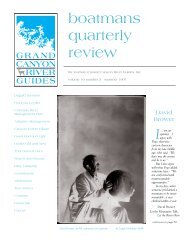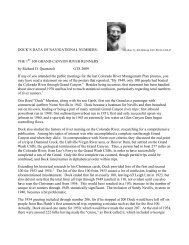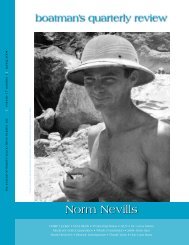fall 11 / 24:3 - Grand Canyon River Guides
fall 11 / 24:3 - Grand Canyon River Guides
fall 11 / 24:3 - Grand Canyon River Guides
- No tags were found...
Create successful ePaper yourself
Turn your PDF publications into a flip-book with our unique Google optimized e-Paper software.
Goodding’s Willow In <strong>Grand</strong> <strong>Canyon</strong>:Requiem Or Revival?Colorado <strong>River</strong> Mile 70L, Sept.2008-Goodding’s willow site.page 6The loss of ecologically important species isone of the most important human impacts onecosystems, not only in <strong>Grand</strong> <strong>Canyon</strong>, but alsothroughout the world (Stevens and others in prep). In2008, <strong>Grand</strong> <strong>Canyon</strong> Wildlands Council (gcwc) wasgenerously funded by the outfitter-supported <strong>Grand</strong><strong>Canyon</strong> Conservation Fund to examine riparianrestoration options in the Colorado <strong>River</strong> corridor,including segments of tributaries commonly visitedby river runners in <strong>Grand</strong> <strong>Canyon</strong> National Park. Theproject addressed a significant challenge in riparianstewardship in theColorado <strong>River</strong>corridor: decline ofGoodding’s willow(Salicaceae: Salixgooddingii) and Fremontcottonwood(Salicaceae: Populusfremontii) along theriver. During tworiver trips in 2008and 2009, we examinedthe changingdistribution andhealth of Goodding’swillow alongthe Colorado <strong>River</strong>.Wildlands Councilvisited and photographedthe 23 locations at which Gooddings willowor Fremont cottonwood trees existed along the river atand before 1963, and assessed stand health in relationto dam-influenced changes in the riparian environment.We conducted the study to provide the nps withinformation relevant to riparian ecosystem rehabilitation,and also because we were concerned over theimpending demise of tamarisk habitat along the riverdue to the introduced tamarisk leaf beetle (Chrysomelidae:Diorhabda spp.).In light of this summer’s tamarisk beetle defoliationof much of the Colorado <strong>River</strong> corridor in <strong>Grand</strong><strong>Canyon</strong>, we want to share the results of that study withthe river-running community. <strong>Grand</strong> <strong>Canyon</strong> WildlandsCouncil offered this information as a startingplace for collaborative riparian restoration, in particularthe recovery of Gooddings’ willow at these locationswith good historical evidence for the presenceof this characteristic, strongly ecologically interactivespecies (Soule and others 2005). Like many who are familiarwith the river ecosystem, we are concerned that<strong>Grand</strong> <strong>Canyon</strong> songbirds and other wildlife speciesmay be facing a tough future with the rapid loss, atleast functionally, of so much habitat. We are pleasedto learn that the <strong>Grand</strong> <strong>Canyon</strong> Association recentlyreceived funding from the Nina Mason Pulliam CharitableTrust for <strong>Grand</strong> <strong>Canyon</strong> National Park (gcnp) tobegin a pilot restoration effort at Granite Rapid Camp,which is one of the sites identified in this study.Goodding’s WillowGoodding’s willow is a common, native, dioeceous tree(individuals are male or female) that formerly was distributedat scattered localities between Glen <strong>Canyon</strong>Dam and Lake Mead, Arizona (Clover and Jotter 1944).It commonly grows up to about 15 meters in heightand occurs in areas of perennially moist, fine-grained,silt-rich soil. Individual trees can live for at least 86years, as shown by pre-dam to post-dam rematchedphotography of the tree at Granite Park (Turner andKarpiscak 1980); however, the high frequency of heartrot limits its utility in dendrochronological studies(Mast and Waring 1997). This willow species providesexcellent habitat cover for neotropical and otherriparian birds (e.g., Carothers and others 1974, Brownand others 1987), and its population in <strong>Grand</strong> <strong>Canyon</strong>has been affected by reduced flood flows from Glen<strong>Canyon</strong> Dam and post-dam beaver (Castoridae: Castorcanadensis) foraging. Beaver may indirectly influencesite invasion by non-native tamarisk (Tamarix spp.,Mortenson and others 2008), which can colonize theopen riparian habitats.Fremont cottonwood was rare along the Colorado<strong>River</strong> in pre-dam time; however, this species occurredoccasionally along wider reaches of the river (e.g.,Mile 195R, Turner and Karpiscak 1980). Gallery standsof cottonwoods are widely used by many neotropicalmigrant birds and other riparian wildlife (e.g., Carothersand others 1974). Seedling cottonwoods become establishedannually along the Colorado <strong>River</strong>; however,virtually all are lost to beaver attack and no matureplants persist along the post-dam river, except at LeesFerry, where gcwc and Glen <strong>Canyon</strong> nra collaboratedin planting and fencing the trees to protect them frombeaver attack.Information GatheringLarry Stevens inquired of old-time river runners asgrand canyon river guides
















